Anchoring of Copper(II)–Schiff Base Complex in SBA-15 Matrix as Efficient Oxidation and Biomimetic Catalyst
Abstract
1. Introduction
2. Results and Discussion
2.1. Characterization of Cu(II) Complex/SBA-15 Catalytic System
2.1.1. Elemental and Thermal Analysis
2.1.2. Powder X-ray Diffraction
2.1.3. N2 Adsorption–Desorption Isotherms
2.1.4. FTIR Spectroscopy Analysis
2.1.5. XPS Analysis
2.1.6. SEM and TEM Microscopy
2.2. Catalytic Tests
2.2.1. Catalytic Performances of the Cu(II) Complex/SBA-15
2.2.2. Stability of Cu(II) Complex/SBA-15 in the Cyclohexene Oxidation Reaction
2.3. Superoxide Dismutase (SOD) Activity of Cu(II)-BrAld/SBA-15-NH2 Catalyst
3. Materials and Methods
3.1. Materials and Equipment
3.2. Synthesis Procedures
3.2.1. Preparation of Functionalized SBA-15 Silica
3.2.2. Synthesis of the Cu(II) Complex
3.2.3. Cu(II) Complex/SBA-15 Catalyst
3.3. Catalytic Oxidation of Cyclohexene
3.4. Catalysis of Superoxide Dismutation
4. Conclusions
Author Contributions
Funding
Institutional Review Board Statement
Informed Consent Statement
Data Availability Statement
Conflicts of Interest
References
- Cavani, F. Catalytic selective oxidation: The forefront in the challenge for a more sustainable chemical industry. Catal. Today 2010, 157, 8–15. [Google Scholar] [CrossRef]
- Forester, T.; Schunk, S.A.; Jenty, S.A.; Lercherl, J.A. Selective liquid phase oxidation of o-xylene with gaseous oxygen by transition metal containing polysiloxane initiator/catalyst systems. J. Catal. 2011, 283, 25–33. [Google Scholar] [CrossRef]
- Sheldon, R.A.; Kochi, J.K. Metal Complex Catalyzed Oxidation of Organic Compounds; Academic Press: New York, NY, USA, 1981. [Google Scholar]
- Cainelli, G.; Cardillo, G. Chromium Oxidation in Organic Chemistry; Springer: New York, NY, USA, 1984. [Google Scholar]
- Zhao, H.; Zhang, R.; Yan, X.; Fan, K. Superoxide dismutase nanozymes: An emerging star for anti-oxidation. J. Mater. Chem. B 2021, 9, 6939–6957. [Google Scholar] [CrossRef]
- Szilágyi, I.; Labádi, I.; Hernadi, K.; Pálinkó, I.; Kiss, T. Synthesis and IR spectroscopic characterisation of immobilised superoxide dismutase (SOD) mimicking complexes. J. Mol. Struct. 2005, 744–747, 495–500. [Google Scholar] [CrossRef]
- Fang, Y.-C.; Lin, H.-C.; Hsu, I.-J.; Lin, T.-S.; Mou, C.-Y. Bioinspired Design of a Cu–Zn–Imidazolate Mesoporous Silica Catalyst System for Superoxide Dismutation. J. Phys. Chem. C 2011, 115, 20639–20652. [Google Scholar] [CrossRef]
- Mureșeanu, M.; Pușcașu, M.; Șomăcescu, S.; Cârjă, G. CuII(Sal-Ala)/CuAlLDH Hybrid as Novel Efficient Catalyst for Artificial Superoxide Dismutase (SOD) and Cyclohexene Oxidation by H2O2. Catal. Lett. 2015, 145, 1529–1540. [Google Scholar] [CrossRef]
- Georgescu, I.; Mureșeanu, M.; Cârjă, G.; Balasanian, I. Hystidine-Salicylaldehyde Schiff Base Cu(II) Complexes Immobilized on Mesoporous Materials as Potentially Biomimetic Oxidation Catalyst. Rev. Chim. 2012, 63, 962–966. [Google Scholar]
- Abbo, H.S.; Titinchi, S.J.J. Metallo Salicylidenetriazol Complexes Encapsulated in Zeolite-Y: Synthesis, Physicochemical Properties and Catalytic Studies. Top. Catal. 2010, 53, 1401–1410. [Google Scholar] [CrossRef]
- Li, Z.; Wu, S.; Ma, Y.; Liu, H.; Hu, J.; Liu, L.; Huo, Q.; Guan, J.; Kank, Q. Encapsulation of tetraazamacrocyclic complexes of cobalt(II), copper(II) and oxovanadium(IV) in zeolite-Y and their use as catalysts for the oxidation of styrene. Transit. Met. Chem. 2013, 38, 243–251. [Google Scholar] [CrossRef]
- Islam, M.; Hossain, D.; Mondal, P.; Tuhina, K.R.; Anupam, S.; Mondal, S.; Mobarak, M. Synthesis, characterization, and catalytic activity of a polymer-supported copper(II) complex with a thiosemicarbazone ligand. Transit. Met. Chem. 2011, 36, 223–230. [Google Scholar] [CrossRef]
- Hu, C.; Zhangz, L.; Zhang, J.; Cheng, L.; Zhai, Z.; Chen, J.; Houh, W. Template-free method to prepare porous Cu-containing nanotubes with a good catalytic performance for styrene epoxidation. Appl. Surf. Sci. 2014, 298, 116–124. [Google Scholar] [CrossRef]
- Alfayate, A.; Márquez-Álvarez, C.; Grande-Casas, M.; Sánchez-Sánchez, M.; Pérez-Pariente, J. Ti(III)APO-5 materials as selective catalysts for the allylic oxidation of cyclohexene: Effect of Ti source and Ti content. Catal. Today 2014, 227, 57–64. [Google Scholar] [CrossRef]
- Carneiro, L.; Silva, A.R.; Shuttleworth, P.S.; Budarin, V.; Clark, J.H. Synthesis, Immobilization and Catalytic Activity of a Copper(II) Complex with a Chiral Bis(oxazoline). Molecules 2014, 19, 11988. [Google Scholar] [CrossRef]
- Malumbazo, N.; Mapolie, S.F. Silica immobilized salicylaldimine Cu(II) and Co(II) complexes as catalysts in cyclohexene oxidation: A comparative study of support effects. J. Mol. Catal. A Chem. 2009, 312, 70–77. [Google Scholar] [CrossRef]
- Jana, S.; Dutta, B.; Bera, R.; Koner, S. Anchoring of Copper Complex in MCM-41 Matrix: A Highly Efficient Catalyst for Epoxidation of Olefins by tert-BuOOH. Langmuir 2007, 23, 2492–2496. [Google Scholar] [CrossRef] [PubMed]
- Zhu, X.; Shen, R.; Zhang, L. Catalytic oxidation of styrene to benzaldehyde over a copper Schiff-base/SBA-15 catalyst. Chin. J. Catal. 2014, 35, 1716–1726. [Google Scholar] [CrossRef]
- Godhani, D.R.; Nakum, H.D.; Parmar, D.K.; Mehta, J.P.; Desai, N.C. Tuning of the reaction parameters to optimize allylic oxidation of cyclohexene catalyzed by zeolite-Y entrapped transition metal complexes. J. Mol. Catal. A Chem. 2016, 415, 37–55. [Google Scholar] [CrossRef]
- Punniyamurthy, T.; Rout, L. Recent advances in copper-catalyzed oxidation of organic compounds. Coord. Chem. Rev. 2008, 252, 134–154. [Google Scholar] [CrossRef]
- Halder, S.; Dey, S.; Rizzoli, C.; Roy, P. Synthesis, characterization and catalytic properties of multinuclear copper(II) complexes. Polyhedron 2014, 78, 85–93. [Google Scholar] [CrossRef]
- Hosseini-Monfared, H.; Soleymani-Babadi, S.; Sadighians, S.; Paziop, A.; Woźniak, K.; Siczek, M.; Mayer, P. Syntheses, structures and catalytic activities of dinuclear copper complexes with tetradentate diaminebis (phenolate) ligands. Transition Met. Chem. 2015, 40, 255–267. [Google Scholar] [CrossRef]
- Trifunschi, S.; Munteanu, M.F. Synthesis, characterization and antioxidant activity of cooper-quercetin complex and iron-quercetin complex. Rev. Chim. 2018, 69, 2621–2624. [Google Scholar] [CrossRef]
- Juyal, V.K.; Pathak, A.; Panwar, M.; Thakuri, S.C.; Prakash, O.; Agrwal, A.; Nand, D. Schiff base metal complexes as a versatile catalyst: A review. J. Organometal. Chem. 2023, 999, 122825. [Google Scholar] [CrossRef]
- Neshat, A.; Cheraghi, M.; Kucerakova, M.; Dusek, M.; Mousavizadeh Mobarakeh, A. A Cu(II) complex based on a Schiff base ligand derived from Ortho-vanillin: Synthesis, DFT analysis and catalytic activities. J. Mol. Struct. 2023, 1274, 134545. [Google Scholar] [CrossRef]
- Zhao, D.; Hu, Q.; Feng, J.; Chmelkac, B.F.; Stucky, G.D. Nonionic Triblock and Star Diblock Copolymer and Oligomeric Surfactant Syntheses of Highly Ordered, Hydrothermally Stable, Mesoporous Silica Structures. J. Am. Chem. Soc. 1998, 120, 6024–6036. [Google Scholar] [CrossRef]
- Kang, T.; Park, Y.; Yi, J. Highly Selective Adsorption of Pt2+ and Pd2+ Using Thiol-Functionalized Mesoporous Silica. Ind. Eng. Chem. Res. 2004, 43, 1478–1484. [Google Scholar] [CrossRef]
- Chanquía, C.M.; Sapags, K.; Rodríguez-Castellón, E.; Herrero, E.R.; Eimer, G.A. Nature and Location of Copper Nanospecies in Mesoporous Molecular Sieves. J. Phys. Chem. C 2010, 114, 1481–1490. [Google Scholar] [CrossRef]
- Papavasiliou, J.; Avgouropoulos, G.; Ioannides, T. Combined steam reforming of methanol over Cu–Mn spinel oxide catalysts. J. Catal. 2007, 251, 7–20. [Google Scholar] [CrossRef]
- Espinós, J.P.; Morales, J.; Barranco, B.A.; Caballero, A.; Holgadoh, J.P.; González-Elipe, A.R. Interface Effects for Cu, CuO, and Cu2O Deposited on SiO2 and ZrO2. XPS Determination of the Valence State of Copper in Cu/SiO2 and Cu/ZrO2 Catalysts. J. Phys. Chem. B 2002, 106, 6921–6929. [Google Scholar] [CrossRef]
- Jirka, I.; Bosacek, V. ESCA study of Cu2+-Y and Cu2+-ZSM-5. Zeolites 1991, 11, 77–80. [Google Scholar] [CrossRef]
- Silva, A.R.; Guimarães, V.; Carneiro, L.; Nunes, N.; Borges, S.; Pires, J.; Martins, A.; Carvalho, A.P. Copper(II) aza-bis(oxazoline) complex immobilized onto ITQ-2 and MCM-22 based materials as heterogeneous catalysts for the cyclopropanation of styrene. Micropor. Mesopor. Mater. 2013, 179, 231–241. [Google Scholar] [CrossRef]
- Czaikowski, M.E.; McNeece, A.J.; Boyn, J.-N.; Jesse, K.A.; Anferov, S.W.; Filatov, A.S.; Mazziotti, D.A.; Anderson, J.S. Generation and Aerobic Oxidative Catalysis of a Cu(II) Superoxo Complex Supported by a Redox-Active Ligand. J. Am. Chem. Soc. 2022, 144, 15569–15580. [Google Scholar] [CrossRef] [PubMed]
- Petsi, M.; Orfanidou, M.; Zografos, A.L. Organocatalytic epoxidation and allylic oxidation of alkenes by molecular oxygen. Green Chem. 2021, 23, 9172–9178. [Google Scholar] [CrossRef]
- Pour, S.R.; Abdolmaleki, A.; Dinari, M. Immobilization of new macrocyclic Schiff base copper complex on graphene oxide nanosheets and its catalytic activity for olefins epoxidation. J. Mater. Sci. 2019, 54, 2885–2896. [Google Scholar] [CrossRef]
- Kundu, K.B.; Chahabra, V.; Malviya, N.; Ganguly, R.; Mishra, G.S.; Mukhopadhyay, S. Zeolite encapsulated host-guest Cu(II) Schiff base complexes: Superior activity towards oxidation reactions over homogenous catalytic systems. Micropor. Mesopor. Mater. 2018, 271, 100–117. [Google Scholar] [CrossRef]
- Khare, S.; Chokharec, R. Oxidation of cyclohexene catalyzed by Cu(Salen) intercalated α-zirconium phosphate using dry tert-butylhydroperoxide. J. Mol. Catal. A Chem. 2012, 353–354, 138–147. [Google Scholar] [CrossRef]
- Chanquía, C.M.; Cánepa, A.L.; Bazán-Aguirre, J.; Sapag, K.; Rodríguez-Castellón, E.; Reyes, P.; Herrero, E.R.; Casuscelli, S.G.; Eimer, G.A. Copper-containing spherical mesoporous silicates prepared by template-ion exchange: A multitechnique characterization and oxidation properties. Micropor. Mesopor. Mater. 2012, 151, 2–12. [Google Scholar] [CrossRef]
- Szilágyi, I.; Labádi, I.; Hernadi, K.; Pálinkó, I.; Feketef, I.; Korecz, L.; Rockenbauer, A.; Kiss, T. Superoxide dismutase activity of a Cu–Zn complex—Bare and immobilized. New J. Chem. 2005, 29, 740–745. [Google Scholar] [CrossRef]
- Szilágyi, I.; Berkesi, O.; Sipiczki, M.; Korecz, L.; Rockenbauer, A.; Pálinkó, I. Preparation, Characterization and Catalytic Activities of Immobilized Enzyme Mimics. Catal. Lett. 2009, 127, 239–247. [Google Scholar] [CrossRef]
- Gulzar, A.; Mahmud, T.; Mitu, L.; Munir, R.; Imran, M.; Iftikar, K. Synthesis, Characterization and Biological Activities of a Schiff Base Derived from 2-[(1,3-benzothiazol-2-yl)sulfanyl]-N-[4-(hydrazinecarbonyl)phenyl]acetamide and its Complexes with Mn(II), Co(II), Ni(II), Cu(II) and Zn(II) Ions. Rev. Chim. 2019, 70, 596–601. [Google Scholar] [CrossRef]
- Zhao, D.; Feng, J.; Huoh, Q.; Melosh, N.; Fredrickson, G.H.; Chmelka, B.F.; Stuckys, G.D. Triblock Copolymer Syntheses of Mesoporous Silica with Periodic 50 to 300 Angstrom Pores. Science 1998, 279, 548–552. [Google Scholar] [CrossRef]
- Martin, T.; Galarneau, A.; Brunel, D.; Izard, V.; Hulea, V.; Blancb, A.C.; Abramson, S.; di Renzo, F.; Fajula, F. 29-O-02 Towards total hydrophobisation of MCM-41 type silica surface. Stud. Surf. Sci. Catal. 2001, 135, 4621–4628. [Google Scholar]
- McKay, M.G.; Friedrich, H.B.; Howie, R.A.; Maguire, G.E.M. 7,11,15,28-Tetra kis[(2-formyl phen oxy)methyl]-1,21,23,25-tetra methyl resorcin[4]arene cavitand ethyl acetate clathrate at 173 K. Acta Cryst. 2009, E65, 0631–0632. [Google Scholar]
- Beauchamp, C.; Fridovich, I. Superoxide dismutase: Improved assays and an assay applicable to acrylamide gels. Anal. Biochem. 1971, 44, 276–287. [Google Scholar] [CrossRef] [PubMed]
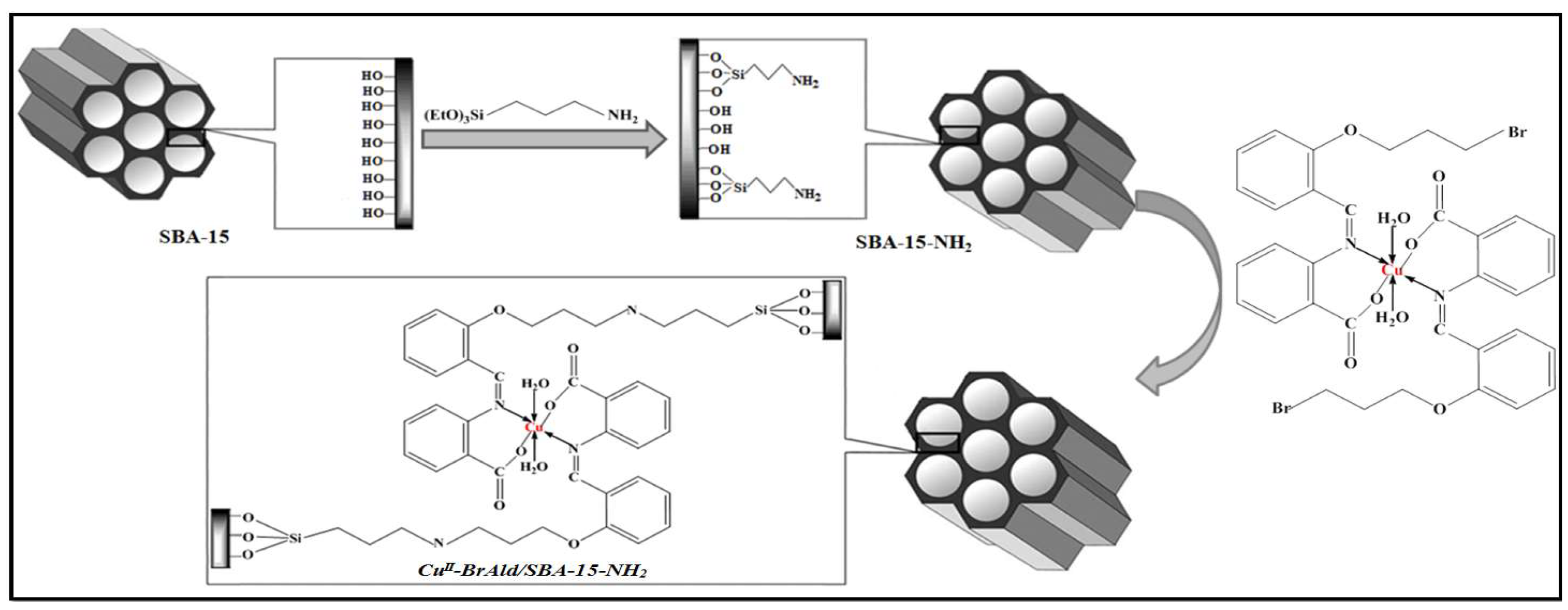
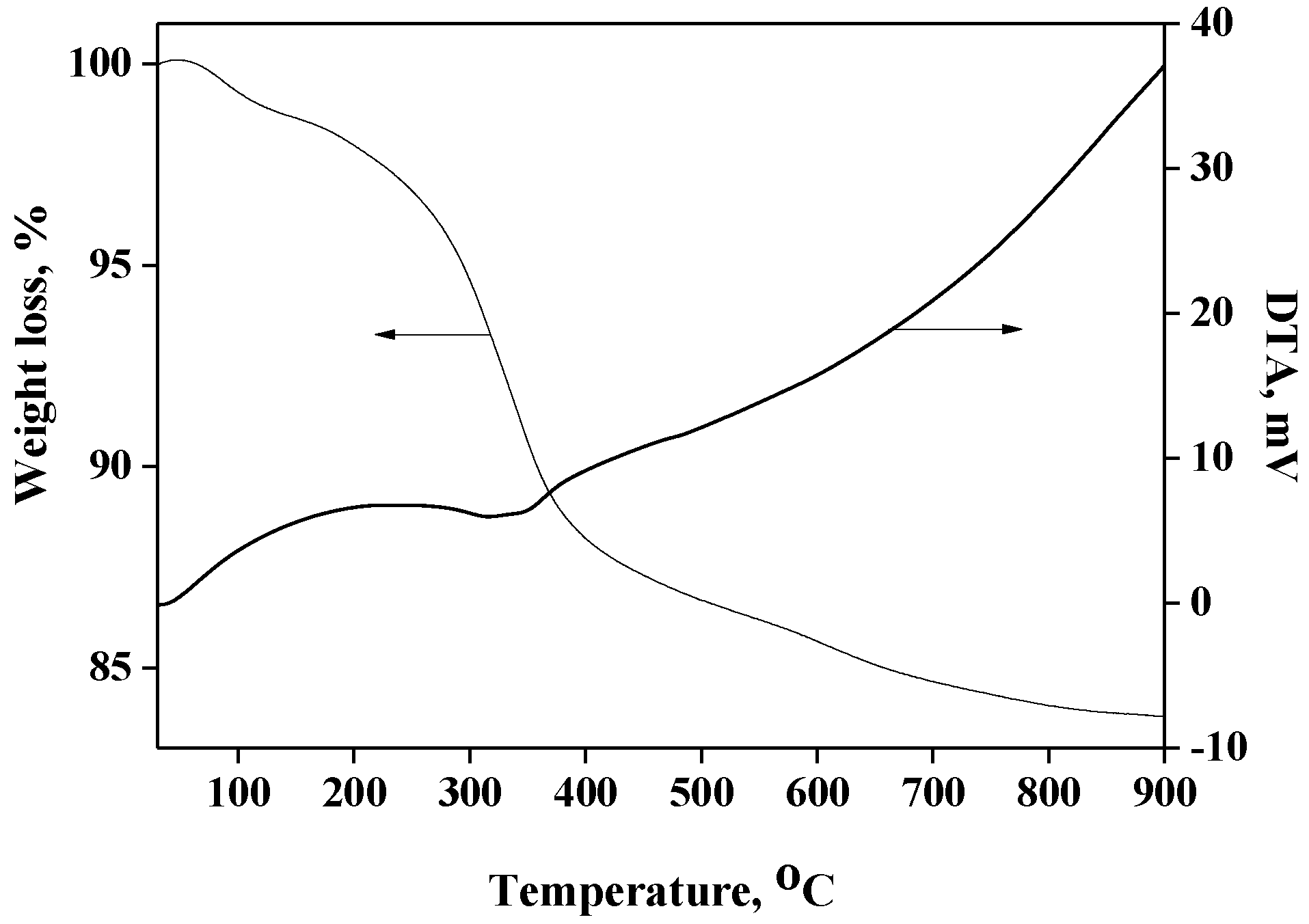
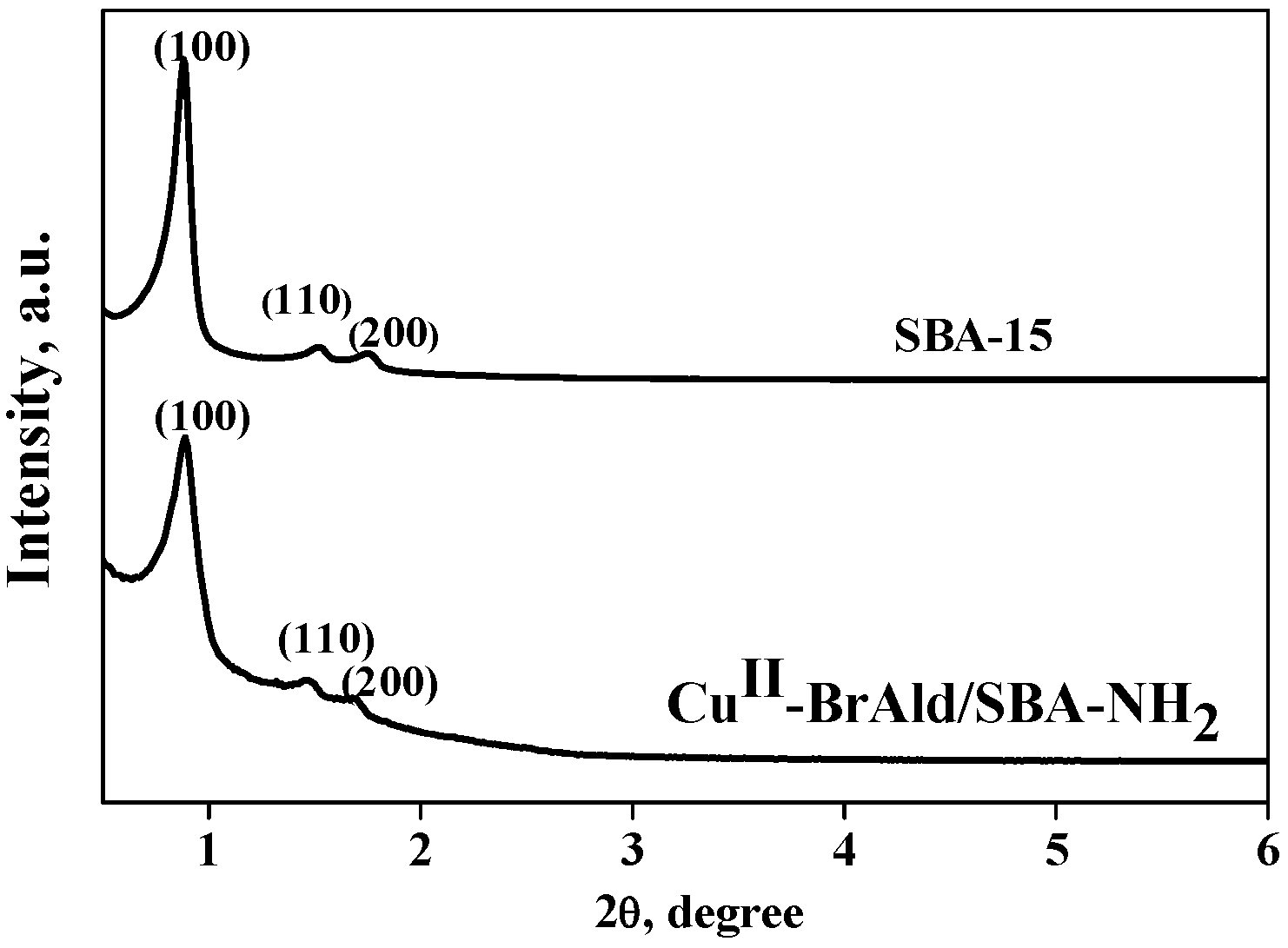
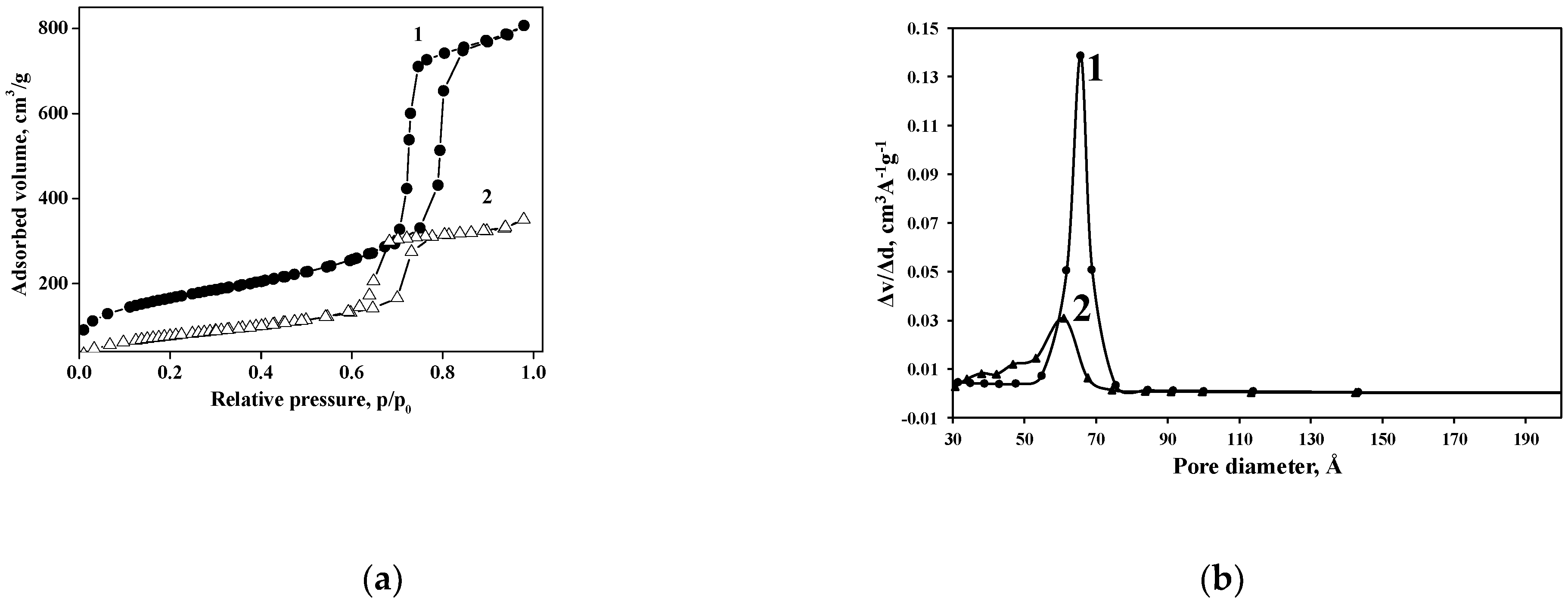

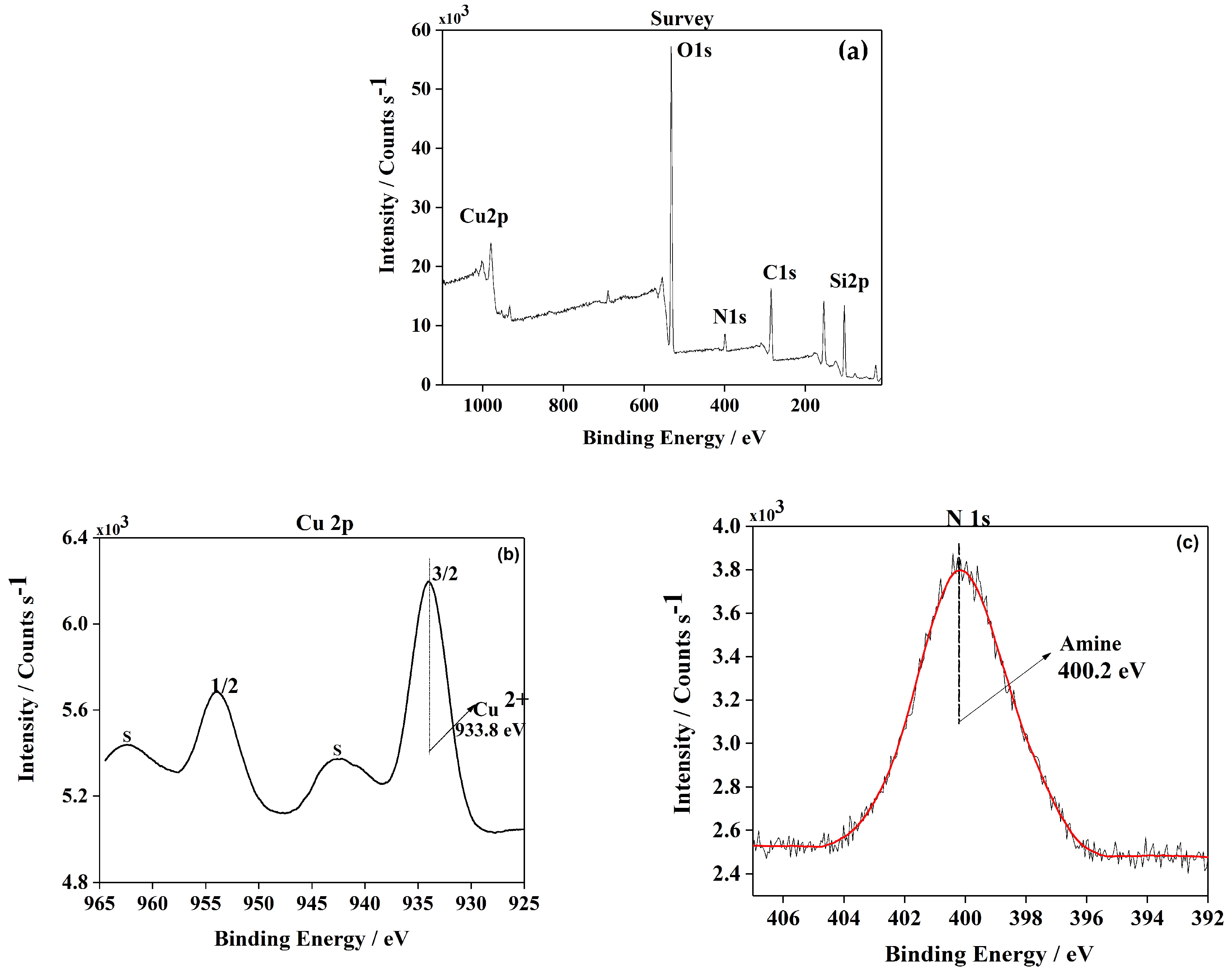

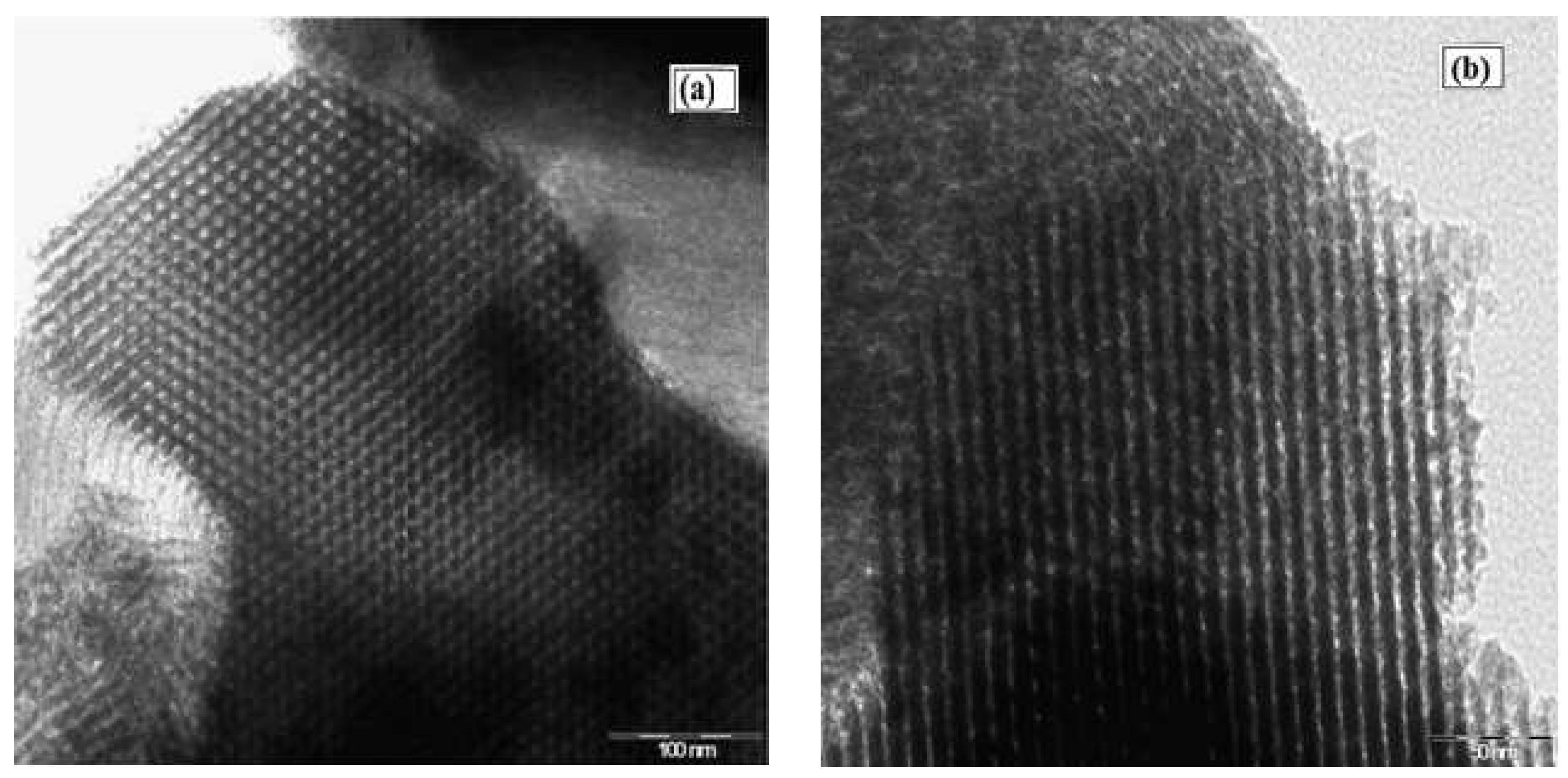

| Compound | Analytical Data a (%) | Complex Amount b (mg g−1) | Cu Amount (mg g−1) | Cu/N Molar Ratio | |||
|---|---|---|---|---|---|---|---|
| C | H | N | Cu | ||||
| Cu(II)-BrAld, C34H34O8N2Br2Cu | 49.54 (49.66) | 4.15 (4.14) | 3.40 (3.41) | 7.52 (7.73) | - | 1/2 | |
| Cu(II)-BrAld/SBA-15-NH2 | 7.92 (7.84) | 0.69 (0.65) | 0.51 (0.53) | 0.56 (0.57) | 119.07 | 5.72 | 1/4 |
| Sample | a0 (nm) a | SBET (m2g−1) b | Vp (mL g−1) c | Dp (nm) d | Wall Thickness (nm) e |
|---|---|---|---|---|---|
| SBA-15 | 11.3 | 600 | 1.1 | 7.8 | 3.5 |
| Cu(II)-BrAld/SBA-15-NH2 | 11.2 | 287 | 0.46 | 6 | 5.2 |
| Sample | CH Conversion (%) | TOF (h−1) | Selectivity (%) | ||
|---|---|---|---|---|---|
| I | II | III | |||
| Cu(II)-BrAld | 11 | 12 | 68 | 22 | 10 |
| Cu(II)-BrAld/SBA-15-NH2 | 75 | 130 | 15 | 45 | 40 |
| No. of Cycle | CH Conversion % | Initial TOF (h−1) |
|---|---|---|
| 1 | 75 | 130 |
| 2 | 74 | 129 |
| 3 | 73 | 127 |
| 4 | 72 | 126 |
| 5 | 70 | 125 |
Disclaimer/Publisher’s Note: The statements, opinions and data contained in all publications are solely those of the individual author(s) and contributor(s) and not of MDPI and/or the editor(s). MDPI and/or the editor(s) disclaim responsibility for any injury to people or property resulting from any ideas, methods, instructions or products referred to in the content. |
© 2024 by the authors. Licensee MDPI, Basel, Switzerland. This article is an open access article distributed under the terms and conditions of the Creative Commons Attribution (CC BY) license (https://creativecommons.org/licenses/by/4.0/).
Share and Cite
Mureseanu, M.; Bleotu, I.; Spînu, C.-I.; Cioatera, N. Anchoring of Copper(II)–Schiff Base Complex in SBA-15 Matrix as Efficient Oxidation and Biomimetic Catalyst. Int. J. Mol. Sci. 2024, 25, 1094. https://doi.org/10.3390/ijms25021094
Mureseanu M, Bleotu I, Spînu C-I, Cioatera N. Anchoring of Copper(II)–Schiff Base Complex in SBA-15 Matrix as Efficient Oxidation and Biomimetic Catalyst. International Journal of Molecular Sciences. 2024; 25(2):1094. https://doi.org/10.3390/ijms25021094
Chicago/Turabian StyleMureseanu, Mihaela, Irina Bleotu, Cezar-Ionuț Spînu, and Nicoleta Cioatera. 2024. "Anchoring of Copper(II)–Schiff Base Complex in SBA-15 Matrix as Efficient Oxidation and Biomimetic Catalyst" International Journal of Molecular Sciences 25, no. 2: 1094. https://doi.org/10.3390/ijms25021094
APA StyleMureseanu, M., Bleotu, I., Spînu, C.-I., & Cioatera, N. (2024). Anchoring of Copper(II)–Schiff Base Complex in SBA-15 Matrix as Efficient Oxidation and Biomimetic Catalyst. International Journal of Molecular Sciences, 25(2), 1094. https://doi.org/10.3390/ijms25021094





